Waterborne Disease Risk Assessment and Mapping for a Floating Village by Combining 3D Hydraulic Simulation and Quantitative Microbial Risk Assessment
Abstract
:1. Introduction
2. Hydraulic Simulation
2.1. 3D Hydraulic Model
2.2. E. coli Transport Model
3. Preparation of Computational Conditions
3.1. Topography of Water Channels
3.1.1. Detection of Location and Network of Water Channels
3.1.2. Sounding Survey
3.1.3. Interpolation Using a Biharmonic Equation
3.2. Flow Rate of Water Channels
4. 3D Hydraulic Simulation for Chhnok Tru Village
4.1. Computational Conditions of Water Flow
4.2. Computational Conditions of E. coli Transport
4.3. Calculation Results
5. Hazard Map Creation with QMRA
5.1. Dose–Response Model
5.2. Modeling of Ingestion
5.3. Mapping Disease Risk
5.4. Utilization of Disease Risk Assessment in Policy Making
- Policy #1: Relocation of floating houses
- Policy #2: Shift the time for drawing water
- Policy #3: Installing a public water supply
6. Conclusions
Author Contributions
Funding
Data Availability Statement
Acknowledgments
Conflicts of Interest
Abbreviations
| ADCP | Acoustic Doppler current profiler |
| CFU | Colony-forming units |
| DEM | Digital elevation model |
| DN | Digital number |
| E. coli | Escherichia coli |
| GPGPU | General-purpose computing on graphics processing units |
| NDWI | Normalized difference water index |
| MR | Mekong River |
| MRC | Mekong River Commission |
| MSI | Multispectral instrument |
| QMRA | Quantitative microbial risk assessment |
| SRTM3 | NASA Shuttle Radar Topography Mission 3 arc second global |
| TITech-WARM | Tokyo Institute of Technology Water Reservoir Model |
| TSL | Tonle Sap Lake |
| TSR | Tonle Sap River |
| WHO | World Health Organization |
References
- Phoeurn, C.; Ly, S. Assessment of satellite rainfall estimates as a pre-analysis for water environment analytical tools: A case study for Tonle Sap Lake in Cambodia. Eng. J. 2018, 22, 229–241. [Google Scholar] [CrossRef]
- Arias, M.E.; Cochrane, T.A.; Piman, T.; Kummub, M.; Caruso, B.S.; Killeen, T.J. Quantifying changes in flooding and habitats in the Tonle Sap Lake (Cambodia) caused by water infrastructure development and climate change in the Mekong Basin. J. Environ. Manag. 2012, 112, 53–66. [Google Scholar] [CrossRef] [PubMed]
- Mekong River Commission. Overview of the hydrology of the Mekong Basin; Technical Report; Mekong River Commission: Vientiane, Laos, 2005. [Google Scholar]
- Ly, S.; Kim, L.; Demerre, S.; Heng, S. Flood mapping along the lower Mekong River in Cambodia. Eng. J. 2018, 22, 269–278. [Google Scholar] [CrossRef]
- Bonheur, N.; Lane, B.D. Natural resources management for human security in Cambodia’s Tonle Sap Biosphere Reserve. Environ. Sci. Pol. 2002, 5, 33–41. [Google Scholar] [CrossRef]
- Keskinen, M. The Lake with Floating Villages: Socioeconomic Analysis of the Tonle Sap Lake. Water Resour. Dev. 2006, 22, 463–480. [Google Scholar] [CrossRef]
- Johnstone, G.; Puskur, R.; Declerck, F.; Mam, K.; Il, O.; Mak, S.; Pech, B.; Seak, S.; Chan, S.; Hak, S.; et al. Tonle Sap Scoping Report (Project Report: AAS-2013-28); Technical Report; CGIAR Research Program on Aquatic Agricultural Systems: Penang, Malaysia, 2013. [Google Scholar]
- Hori, M.; Ishikawa, S.; Heng, P.; Ly, V.; Nao, T.; Kurokura, H. Role and prospects of fish traders in Cambodian small-scale fishing: The case of Chnnok Tru village, Kampong Chhnang province. In Southeast Asian Water Environment 3; Takizawa, S., Kurisu, F., Satoh, H., Eds.; IWA Publishing: London, UK, 2009; pp. 117–122. [Google Scholar]
- Asian Development Bank. The Tonle Sap Basin Strategy; Technical Report; Asian Development Bank: Manila, Philippines, 2005. [Google Scholar]
- In, S.; Phuong, H.; Hor, S.; Pu, J.; Watanabe, T. Hygiene and Sanitation of people living on and around Tonle Sap Lake: Comparison of water based, water-land based and land based zones. In Proceedings of the 2nd International Symposium on Conservation and Management of Tropical Lakes, Siem Reap, Cambodia, 24–26 August 2017. [Google Scholar]
- Merali, H.S.; Morgan, J.F.; Uk, S.; Phlan, S.; Wang, L.T.; Korng, S. The Lake Clinic—Providing primary care to isolated floating vollages on the Tonle Sap Lake, Cambodia. Rural. Remote. Health 2014, 14, 2612. [Google Scholar]
- Hashimoto, M.; Suetsugi, T.; Ichikawa, Y.; Sunada, K.; Nishida, K.; Kondo, N.; Ishidaira, H. Assessing the relationship between inundation and diarrhoeal cases by flood simulations in low-income communities of Dhaka City, Bangladesh. Hydrol. Res. Lett. 2014, 8, 96–102. [Google Scholar] [CrossRef]
- Kazama, S.; Aizawa, T.; Watanabe, T.; Ranjan, P.; Gunawardhana, L.; Amano, A. A quantitative risk assessment of waterborne infectious disease in the inundation area of a tropical monsoon region. Sustain. Sci. 2012, 7, 45–54. [Google Scholar] [CrossRef]
- Hoyer, A.B.; Schladow, S.G.; Rueda, F.J. A hydrodynamics-based approach to evaluating the risk of waterborne pathogens entering drinking water intakes in an large, stratified lake. Water Res. 2015, 83, 227–236. [Google Scholar] [CrossRef]
- Haas, C.N.; Rose, J.B.; Gerba, C.P. Quantitative Microbial Risk Assessment; John Wiley & Sons, Inc.: New York, NY, USA, 1999. [Google Scholar]
- World Health Organization. Quantitative Microbial Risk Assessment: Application for Water Safety Management; World Health Organization: Geneva, Switzerland, 2016; pp. 171–173. [Google Scholar]
- Amano, A.; Sakuma, T.; Kazama, S.; Gunawardhana, L. Evaluation of diarrhea disease risk attributed to inundation water use on a local scale in Cambodia using hydrological model simulations. River Syst. 2013, 20, 185–196. [Google Scholar] [CrossRef]
- Xu, X.; Nakamura, T.; Kobatashi, Y.; Kojima, T.; Ishikawa, T. Modeling of Saline Water Movement in Tone River Estuary using Three-dimensional CIP-SOROBAN Model. Thai Environ. Eng. J. 2012, 111–115. [Google Scholar]
- Xu, X.; Ishikawa, T.; Nakamura, T. Three-dimensional modeling of hydrodynamics and dissolved oxygen transport in Tone River Estuary. J. JSCE 2013, 1, 194–213. [Google Scholar] [CrossRef] [PubMed]
- Takahira, K.; Wang, M.; Nakamura, T.; Ishikawa, T.; Irie, M.; Tarhouni, J. Numerical study on Seasonal Stratified Flow and Sediment Transport in Joumine Reservoir Tunisia. In Proceedings of the 35th IAHR World Congress, VOLS III and IV, Chengdu, China, 8–13 September 2013. [Google Scholar]
- Yabe, T.; Mizoe, H.; Takizawa, H.; Moriki, H.; Im, H.N.; Ogata, Y. High-order schemes with CIP method and adaptive Soroban grid towards mesh-free scheme. J. Comput. Phys. 2004, 194, 57–77. [Google Scholar] [CrossRef]
- Tan, R.; Chanto, M.C.T.; Ung, P.; Miyanaga, K.; Tanji, Y. Survival of Escherichia coli K12 in Tonle Sap Lake and Tonle Sap Water by Using Dialysis Membrane as a Supporter. In Proceedings of the 2nd International Symposium on Conservation and Management of Tropical Lakes, Siem Reap, Cambodia, 24–26 August 2017; pp. 133–139. [Google Scholar]
- Mekong River Commission (MRC) and Ministry of Public Work and Transport of Cambodia. Hydrographic Atlas Mekong River in Cambodia; Technical Report; Mekong River Commission (MRC) and Ministry of Public Work and Transport of Cambodia: Phnom Penh, Cambodia, 1999.
- Gao, B. NDWI-a normalized difference water index for remote sensing of vegetation liquid water from space. Remote. Sens. Environ. 1996, 58, 257–266. [Google Scholar] [CrossRef]
- McFeeters, S.K. The use of the Normalized Difference Water Index (NDWI) in the delineation of open water features. Int. J. Remote. Sens. 1996, 17, 1425–1432. [Google Scholar] [CrossRef]
- Briggs, I.C. Machine contouring using minimum curvature. Geophysics 1974, 39, 39–48. [Google Scholar] [CrossRef]
- NASA JPL. NASA Shuttle Radar Topography Mission Global 3 arc Second. Distributed by NASA EOSDIS Land Processes Distributed Active Archive Center. 2013. Available online: https://doi.org/10.5067/MEaSUREs/SRTM/SRTMGL3.003 (accessed on 22 September 2023).
- Nakamura, T.; Murakami, S.; Lun, S.; Fujii, H. Efficacy of a GPGPU-Acceleration to Inundation Flow Simulation in Tonle Sap Lake in Cambodia. Eng. J. 2019, 23, 151–169. [Google Scholar] [CrossRef]
- National Institute of Statistics (NIS). General Population Census of Cambodia 1998, Final Census Results, 2nd ed.; Technical Report; Ministry of Planning: Phnom Penh, Cambodia, 2002.
- Tanaka, Y.; Hayashida, S.; Hongo, M. The relationship of the feces protein particles to rice protein bodies. Agr. Biol. Chem. 1975, 39, 515–518. [Google Scholar]
- Ervin, J.S.; Russell, T.L.; Layton, B.A.; Yamahara, K.M.; Wang, D.; Sassoubre, L.M.; Cao, Y.; Kelty, C.A.; Sivaganesan, M.; Boehm, A.B.; et al. Characterization of fecal concentrations in human and other animal sources by physical, culture-based, and quantitative real-time PCR methods. Water Res. 2013, 47, 6873–6882. [Google Scholar] [CrossRef]
- Mackowiak, M.; Leifels, M.; Hamza, I.A.; Jurzik, L.; Wingender, J. Distribution of Escherichia coli, coliphages and enteric viruses in water, epilithic biofilms and sediments of an urban river in Germany. Sience Total. Environ. 2018, 626, 650–659. [Google Scholar] [CrossRef]
- Stocker, M.D.; Smith, J.E.; Hernandez, C.; Macarisin, D.; Pachepsky, Y. Seasonality of E. coli and Enterococci Concentrations in Creek Water, Sediment, and Periphyton. Water Air Soil Pollut. 2019, 230, 223. [Google Scholar] [CrossRef]
- Garzio-Hadzick, A.; Shelton, D.; Hill, R.; Pachepsky, Y.; Guber, A.; Rowland, R. Survival of manure-borne E. coli in streambed sediment: Effects of temperature and sediment properties. Water Res. 2010, 44, 2753–2762. [Google Scholar] [CrossRef] [PubMed]
- Abia, A.L.K.; Ubomba-Jaswa, E.; Momba, M.N.B. Competitive Survival of Escherichia coli, Vibrio cholerae, Salmonella typhimurium and Shigella dysenteriae in Riverbed Sediments. Microb. Ecol. 2016, 72, 881–889. [Google Scholar] [CrossRef] [PubMed]
- Guidelines for Drinking-Water Quality, 4th ed.; Published in 2011 and Complemented by the First Addendum in 2017; Technical Report; World Health Organization: Geneva, Switzerland, 2017.
- Thi, M.H.; Watanabe, T.; Fukushi, K.; Ono, A.; Nakajima, F.; Yamamoto, K. Quantitative Risk Assessment of Infectious Diseases Caused by Waterborne Escherichia coli During Floods in Cities of Developing Countrie. J. Jpn. Soc. Water Environ. 2011, 34, 153–159. [Google Scholar]
- Nutrient Reference Values for Australia and New Zealand Including Recommended Dietary Intakes, 2006, Version 1.2; updated September 2017; Technical Report; National Health and Medical Research Council, Australian Government Department of Health and Ageing, New Zealand Ministry of Health: Canberra, Australian, 2017.
- U.S. EPA. Exposure Factors Handbook 2011 Edition (Final Report); Technical Report; U.S. Environmental Protection Agency: Washington, DC, USA, 2011.
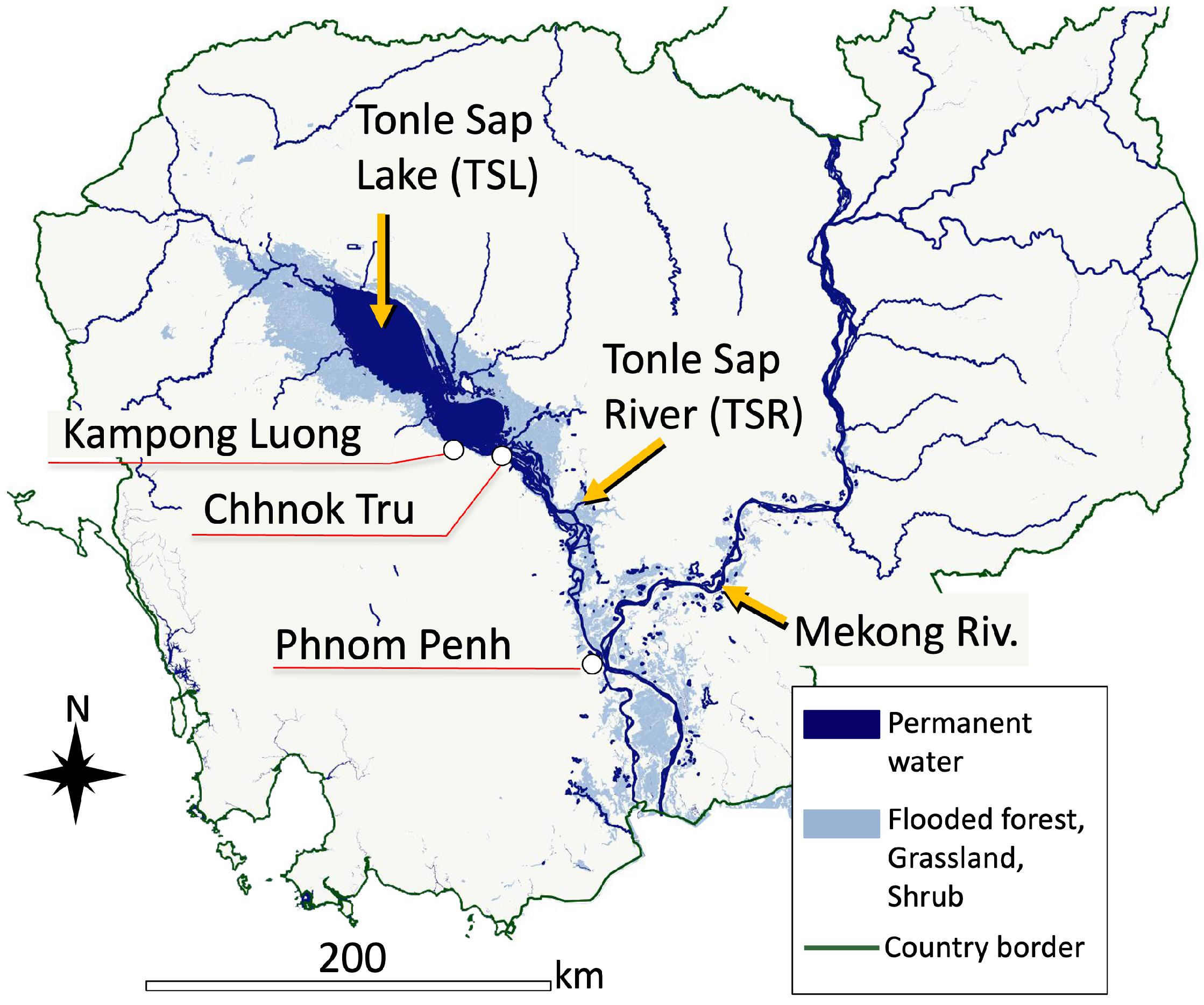
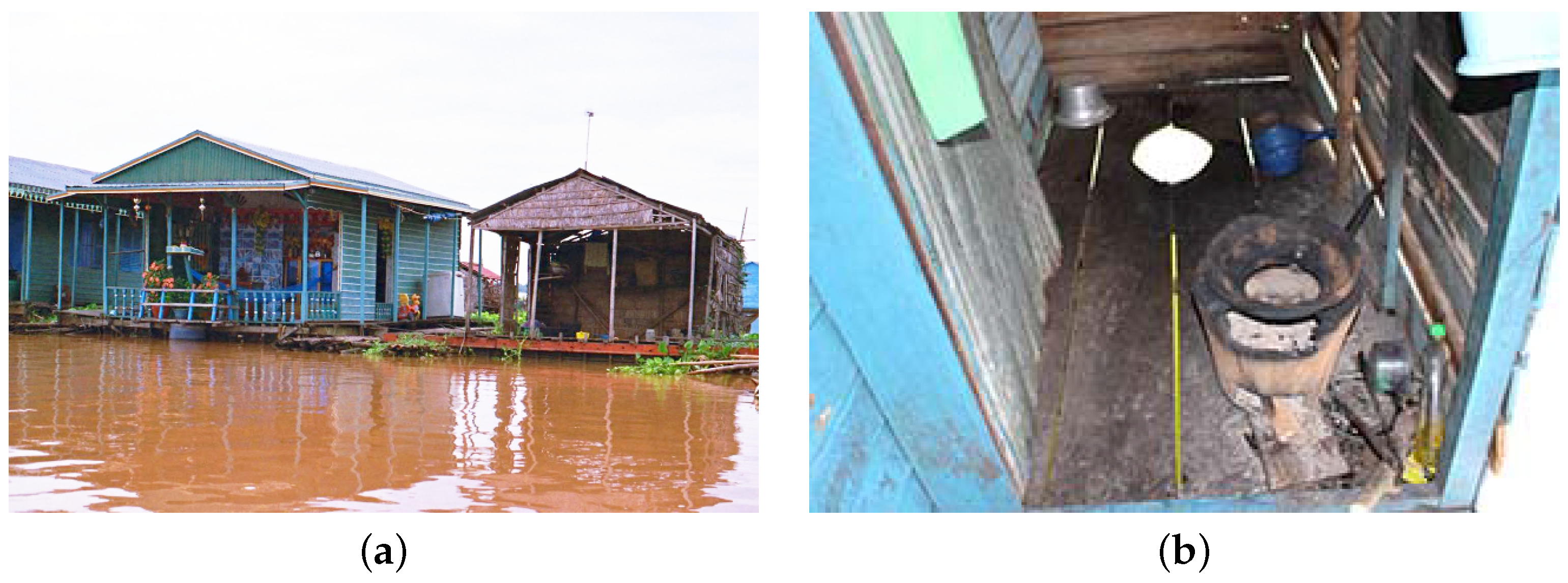

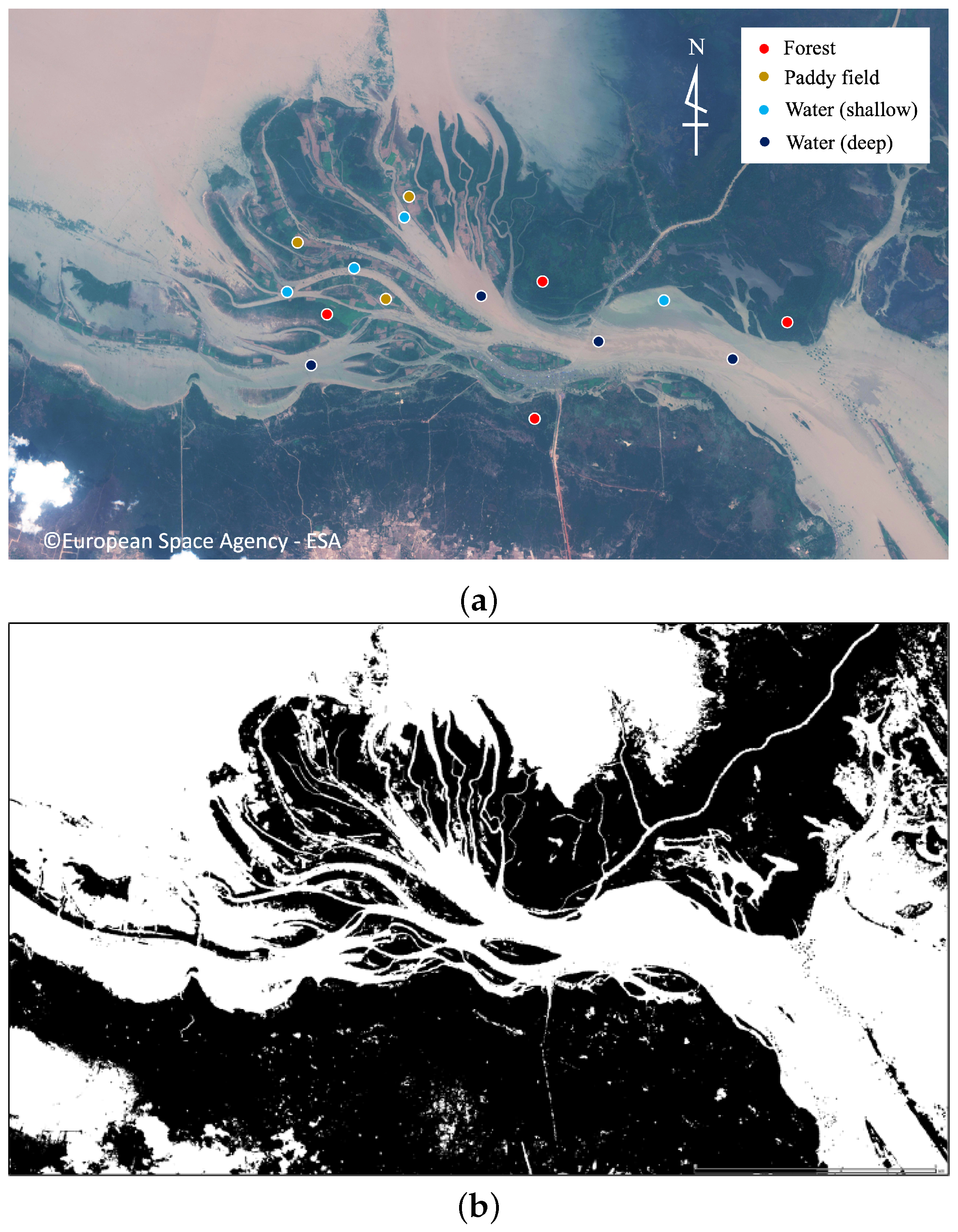
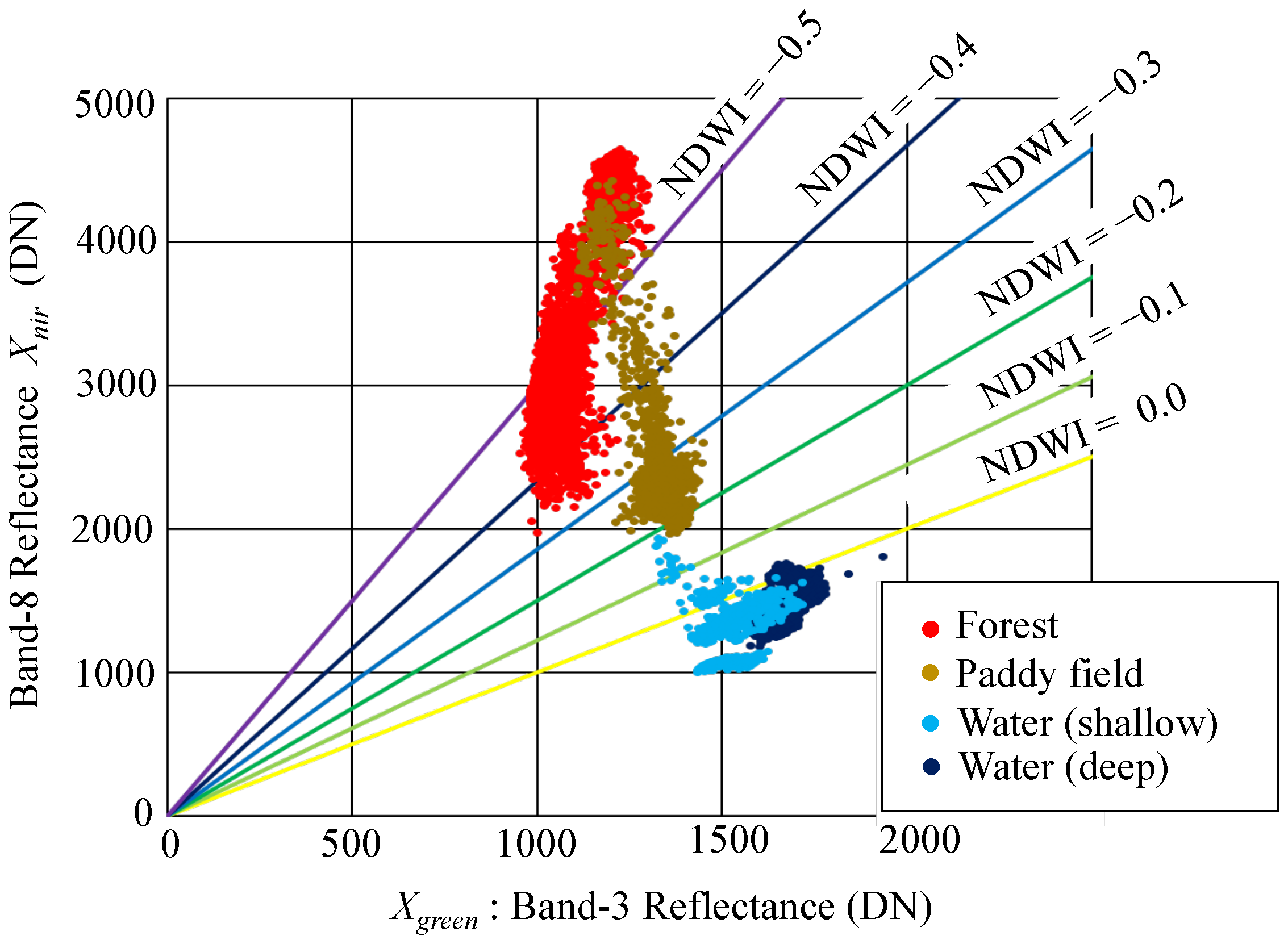
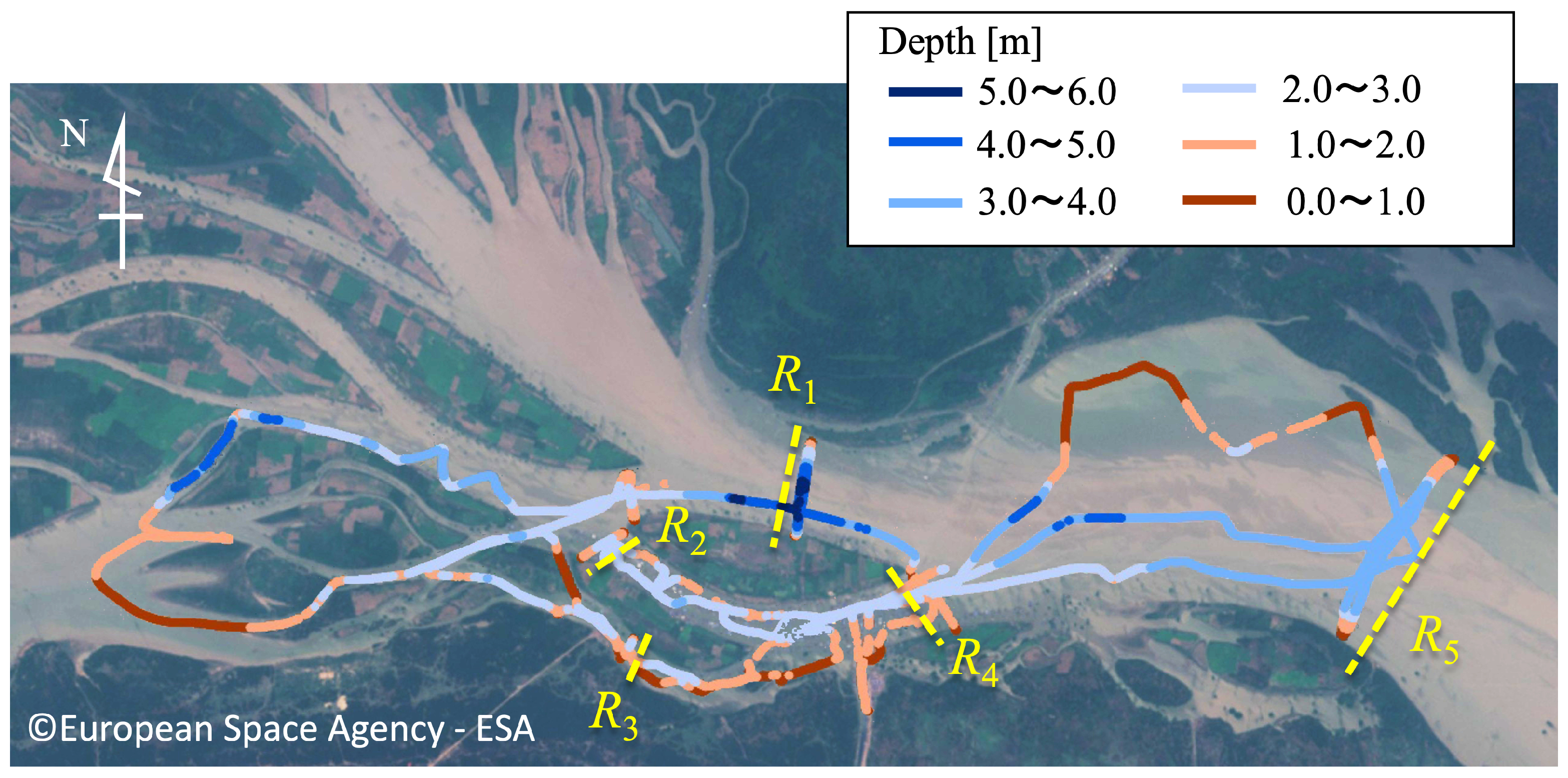
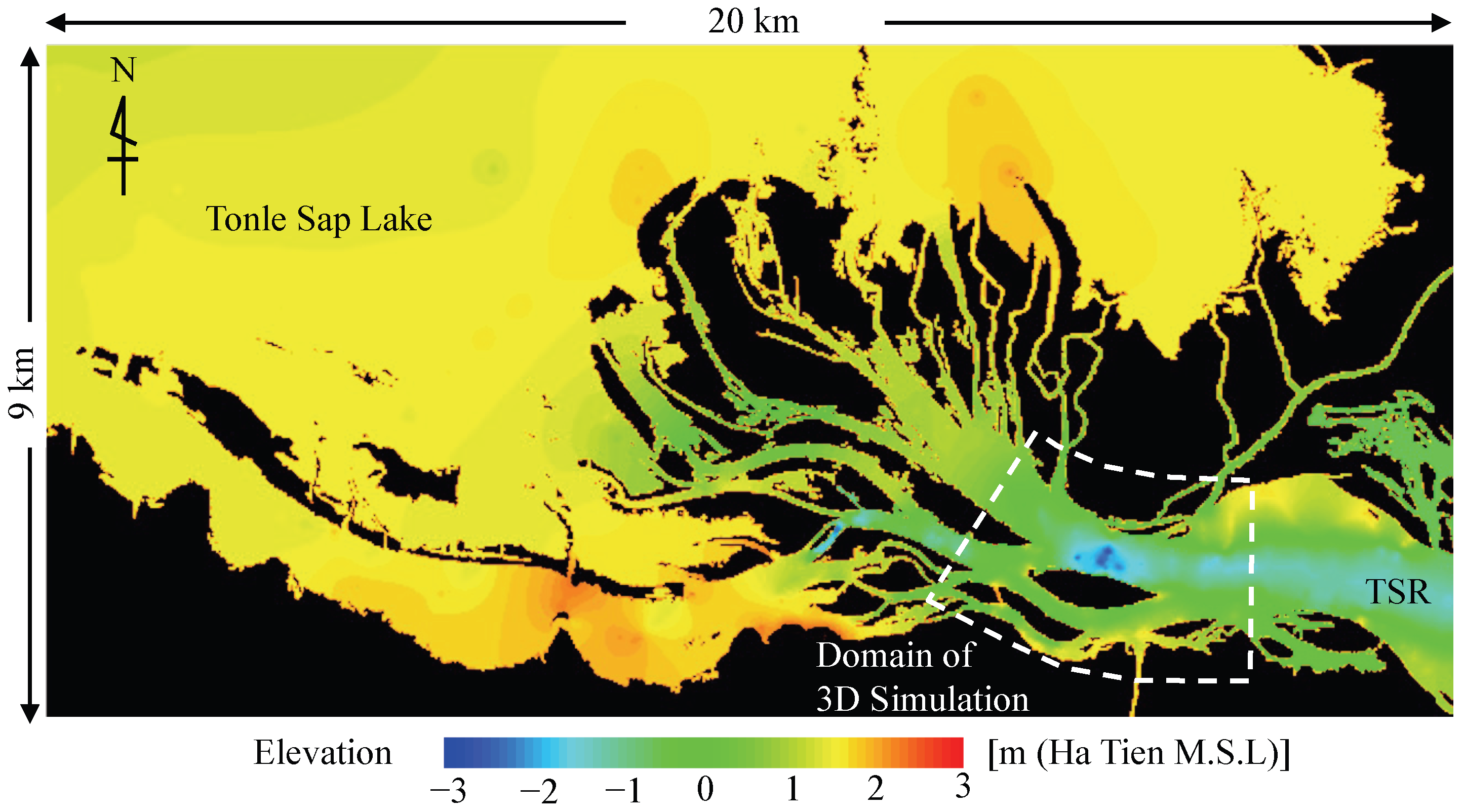

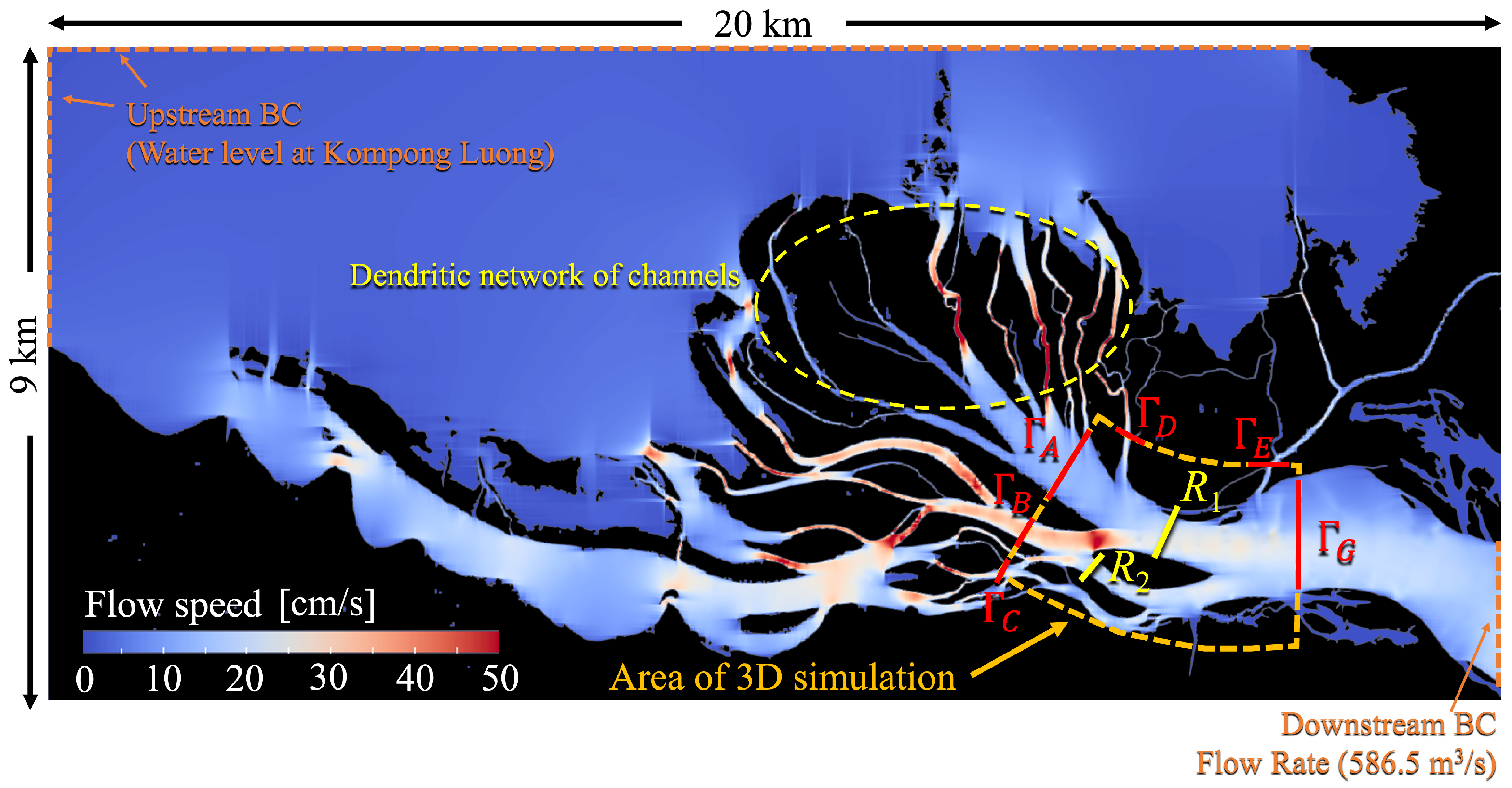


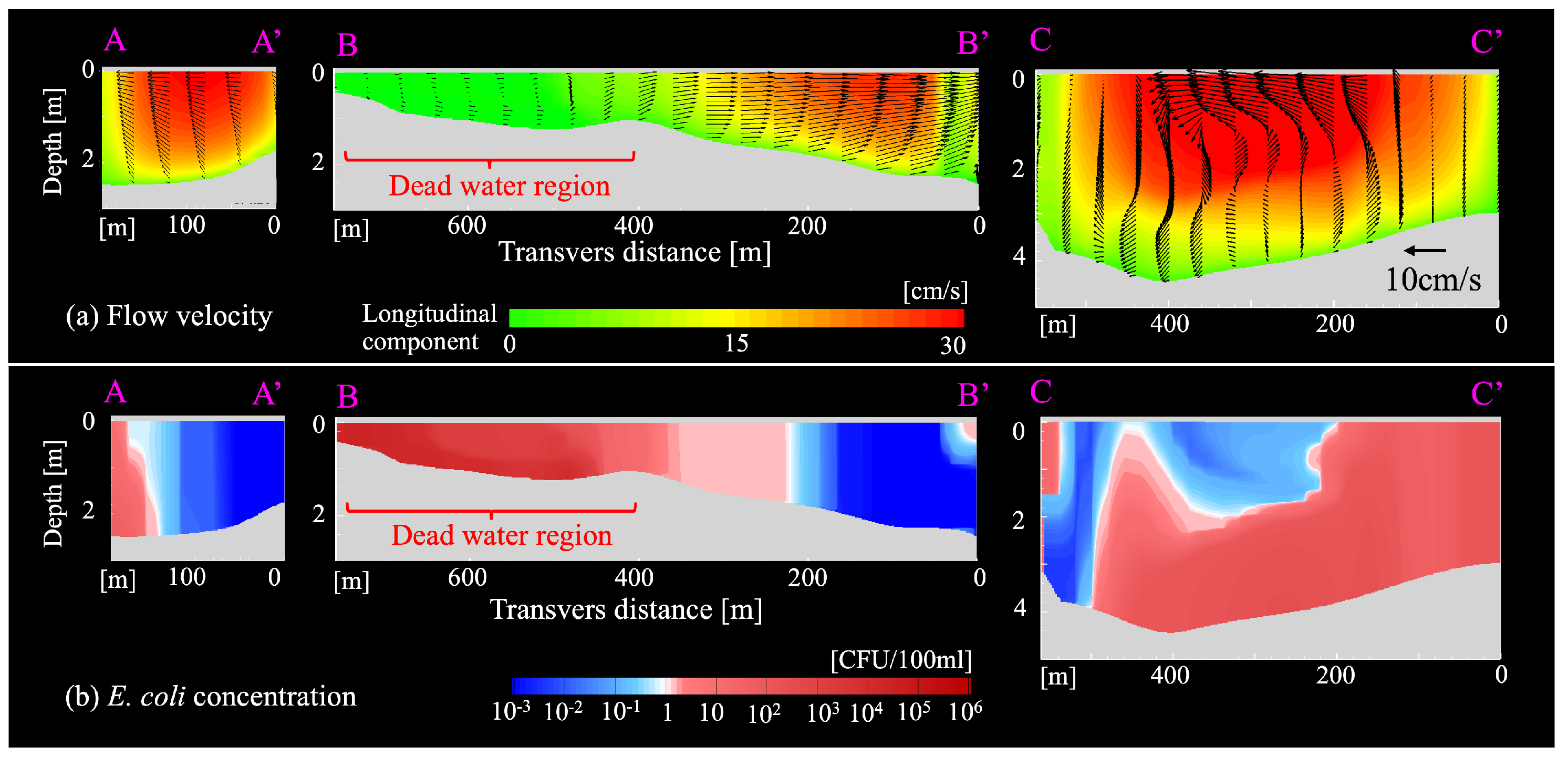
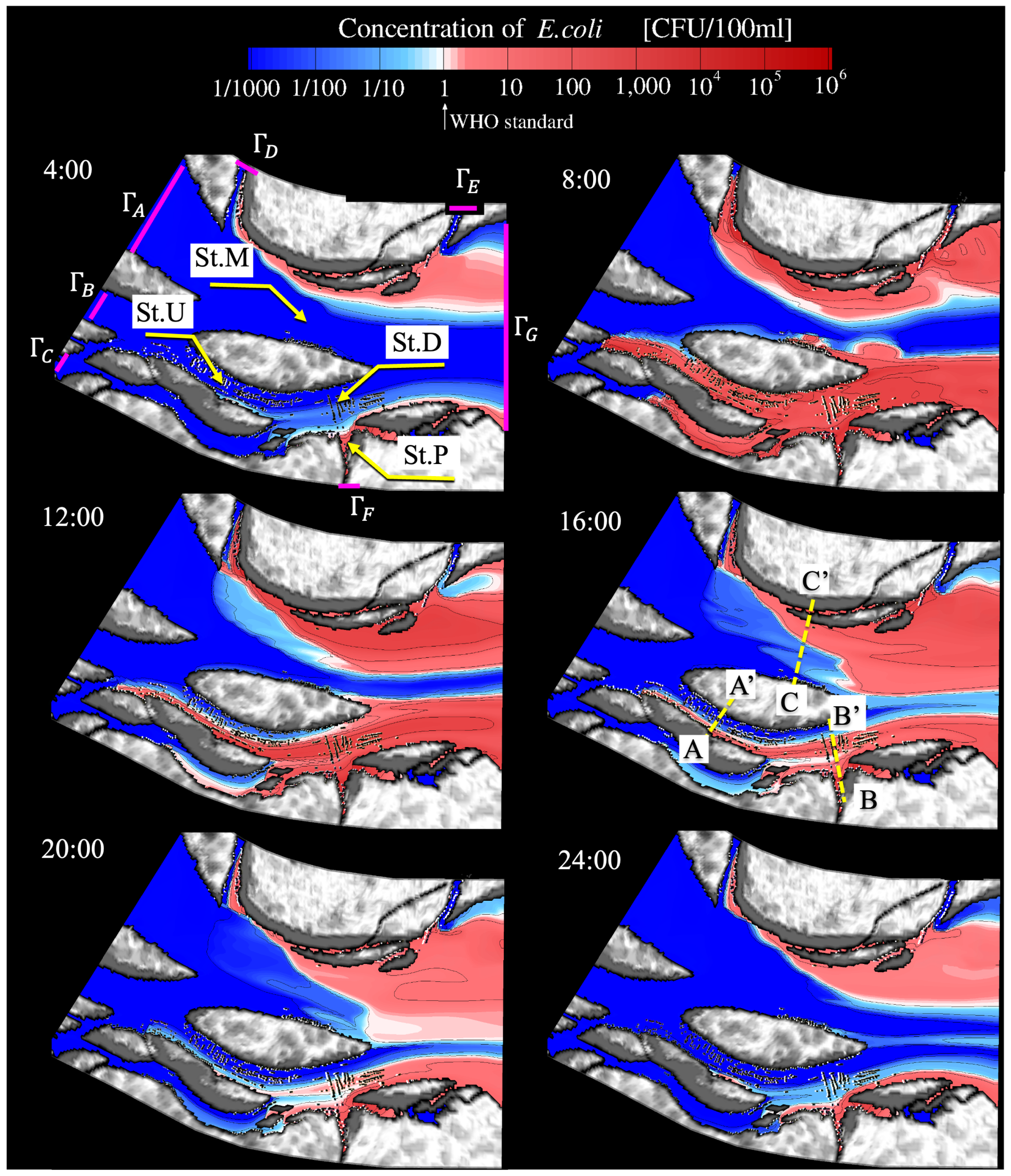
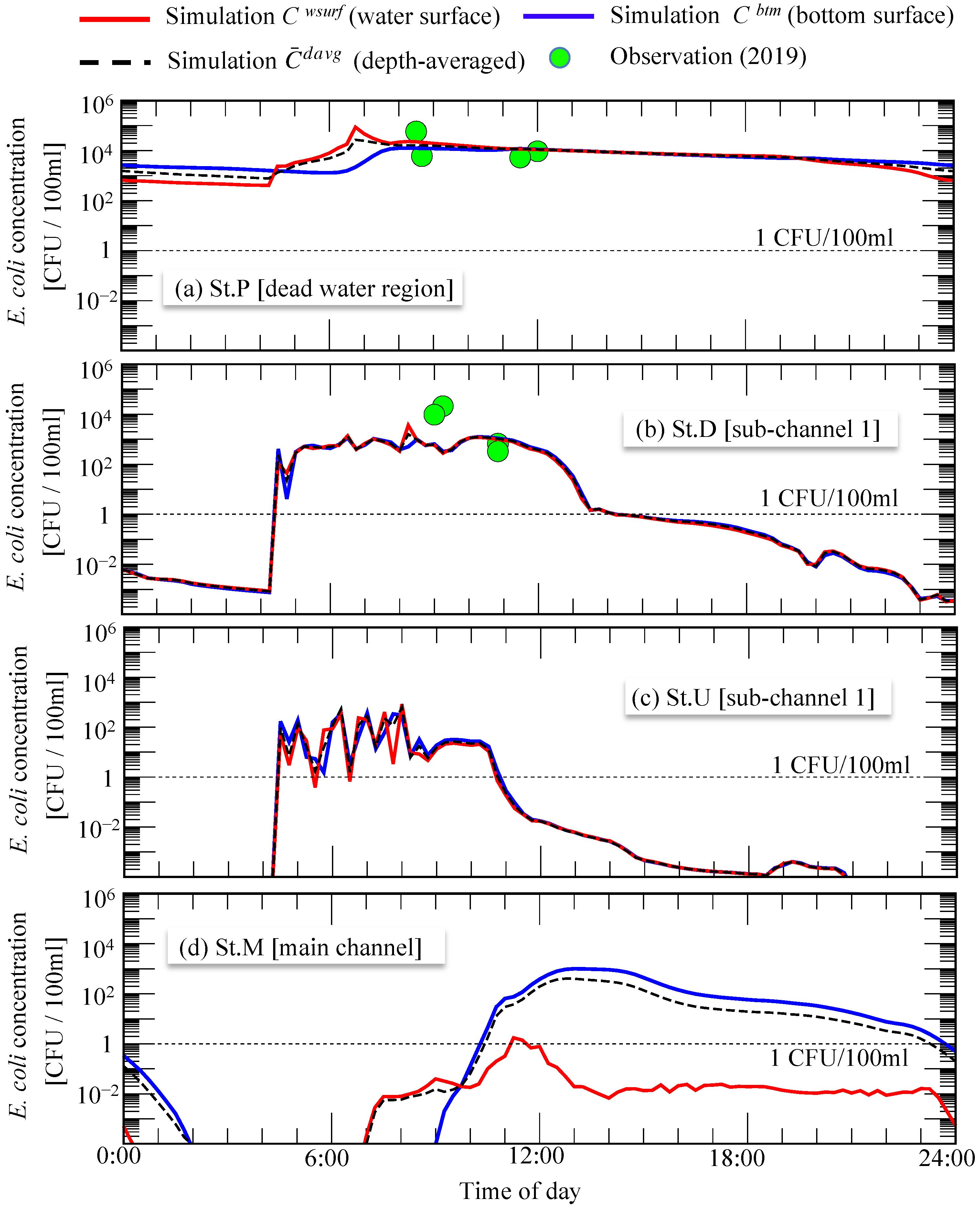
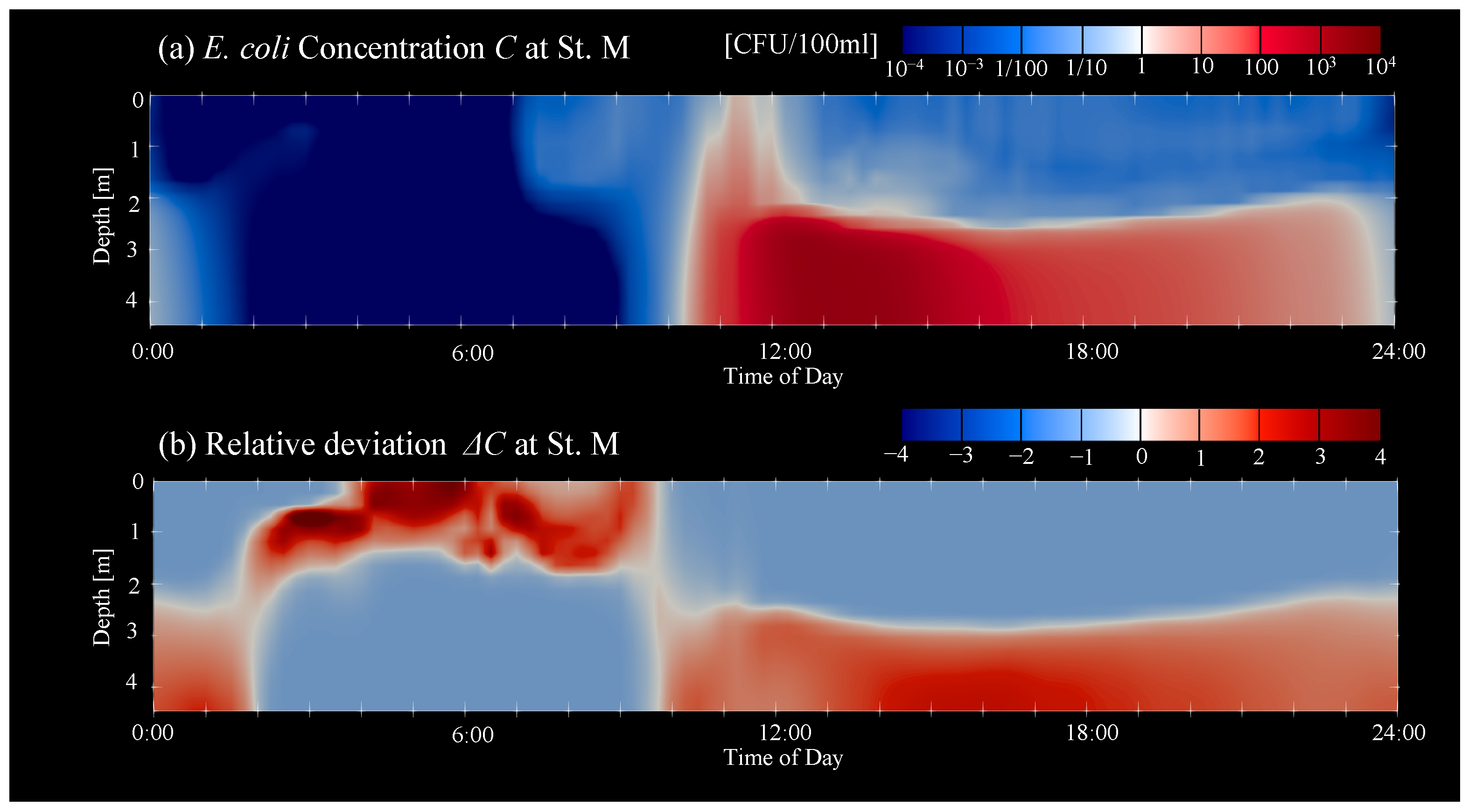
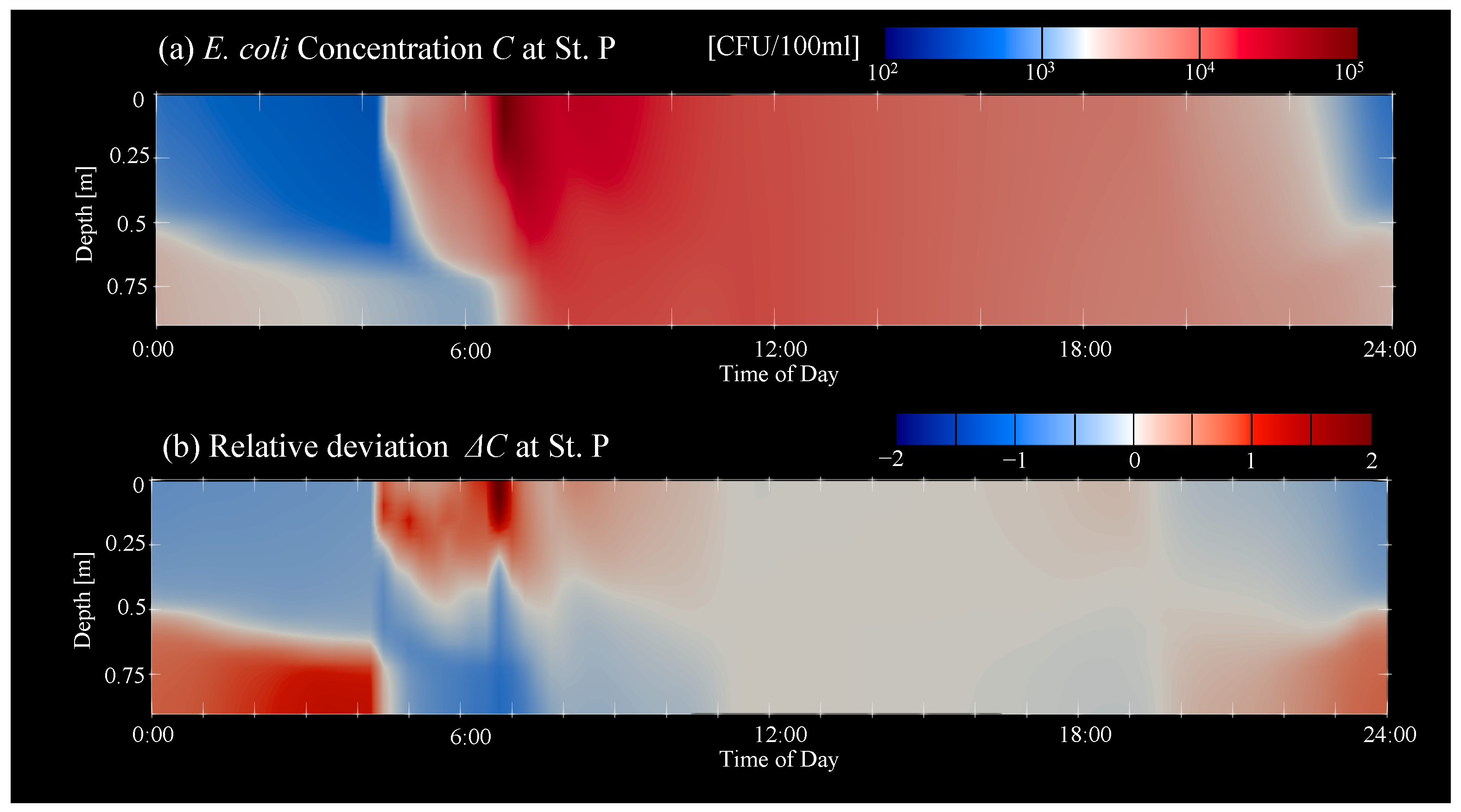


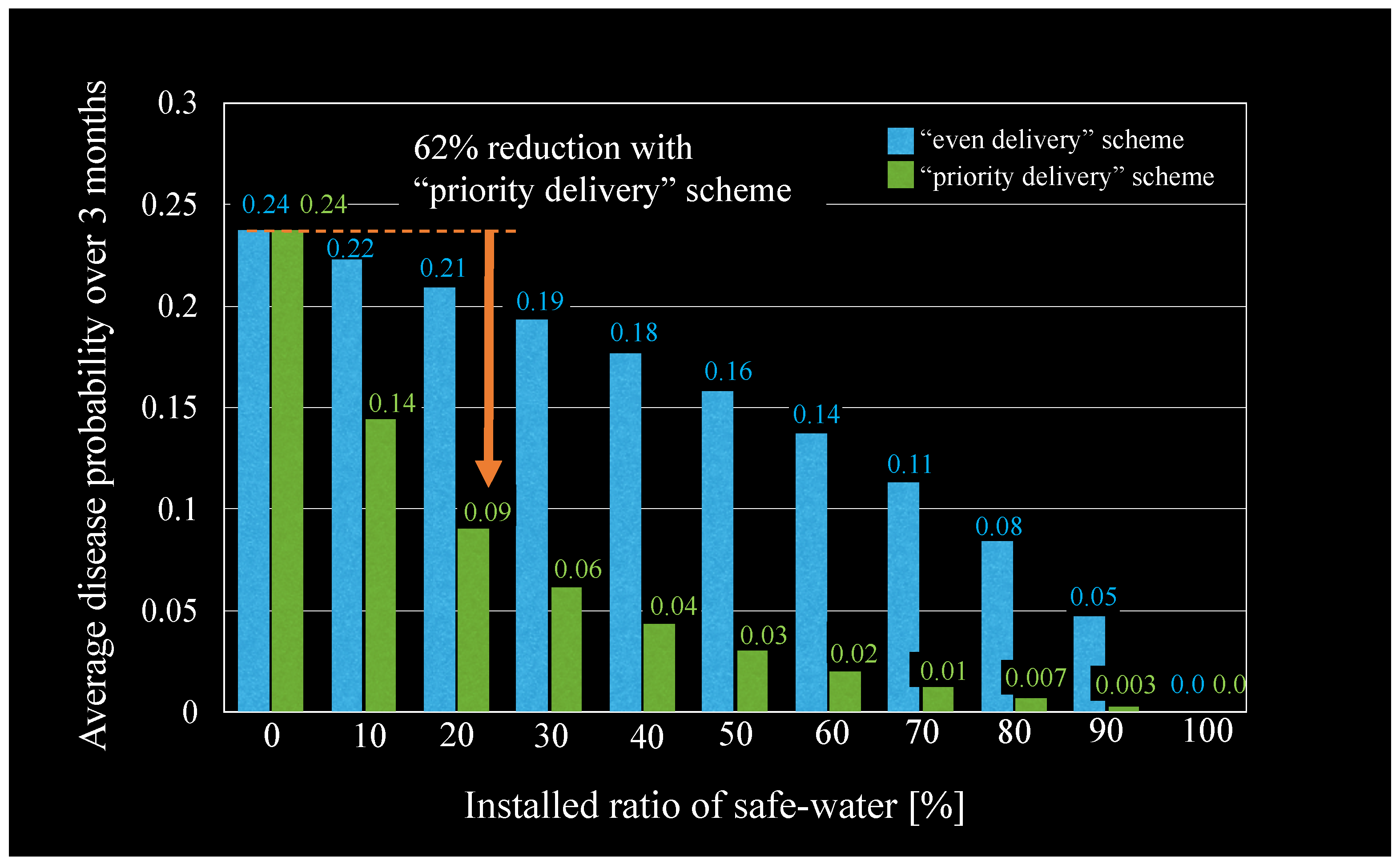
| [m3/s] | [m3/s] | [m3/s] | [m3/s] | [m3/s] | |
|---|---|---|---|---|---|
| Observation | 480.3 ± 37.3 | 61.0 ± 0.6 | 37.4 ± 5.9 | 98.5 ± 6.6 | 586.5 ± 43.9 |
| Simulation (2D model) | 437.0 | 82.0 | 29.9 | 102.4 | 582.9 |
| Simulation (3D model) | 421.0 | 98.3 | 29.2 | 124.5 | - † |
| Inflow boundary | Inflow boundary | ||
| Constant flow rate ( m/s) * | Constant flow rate ( m/s) * | ||
| Observed water temperature ** | Observed water temperature ** | ||
| Inflow boundary | Wall boundary | ||
| Constant flow rate ( m/s) * | Zero flow rate m/s | ||
| Observed water temperature ** | |||
| Inflow boundary | Outflow boundary | ||
| Constant flow rate ( m/s) * | |||
| Observed water temperature ** | Constant water level ( m) * | ||
| Inflow boundary | |||
| Constant flow rate ( m/s) * | |||
| Observed water temperature ** |
| Daily Averaged E. coli Concentration † | Disease Probability over 3 Months ‡ | |||||
|---|---|---|---|---|---|---|
| St. M | 0.07 | 49.57 | 49.50 | 0.00021 | 0.012 | 0.01179 |
| St. P | 8441 | 6962 | −1479 | 0.86 | 0.80 | −0.06 |
Disclaimer/Publisher’s Note: The statements, opinions and data contained in all publications are solely those of the individual author(s) and contributor(s) and not of MDPI and/or the editor(s). MDPI and/or the editor(s) disclaim responsibility for any injury to people or property resulting from any ideas, methods, instructions or products referred to in the content. |
© 2023 by the authors. Licensee MDPI, Basel, Switzerland. This article is an open access article distributed under the terms and conditions of the Creative Commons Attribution (CC BY) license (https://creativecommons.org/licenses/by/4.0/).
Share and Cite
Nakamura, T.; Fujii, H.; Watanabe, T.; Ly, S.; Lun, S.; Fujihara, Y.; Hoshikawa, K.; Miyanaga, K.; Yoshimura, C. Waterborne Disease Risk Assessment and Mapping for a Floating Village by Combining 3D Hydraulic Simulation and Quantitative Microbial Risk Assessment. Water 2023, 15, 4199. https://doi.org/10.3390/w15234199
Nakamura T, Fujii H, Watanabe T, Ly S, Lun S, Fujihara Y, Hoshikawa K, Miyanaga K, Yoshimura C. Waterborne Disease Risk Assessment and Mapping for a Floating Village by Combining 3D Hydraulic Simulation and Quantitative Microbial Risk Assessment. Water. 2023; 15(23):4199. https://doi.org/10.3390/w15234199
Chicago/Turabian StyleNakamura, Takashi, Hideto Fujii, Toru Watanabe, Sarann Ly, Sambo Lun, Yoichi Fujihara, Keisuke Hoshikawa, Kazuhiko Miyanaga, and Chihiro Yoshimura. 2023. "Waterborne Disease Risk Assessment and Mapping for a Floating Village by Combining 3D Hydraulic Simulation and Quantitative Microbial Risk Assessment" Water 15, no. 23: 4199. https://doi.org/10.3390/w15234199
APA StyleNakamura, T., Fujii, H., Watanabe, T., Ly, S., Lun, S., Fujihara, Y., Hoshikawa, K., Miyanaga, K., & Yoshimura, C. (2023). Waterborne Disease Risk Assessment and Mapping for a Floating Village by Combining 3D Hydraulic Simulation and Quantitative Microbial Risk Assessment. Water, 15(23), 4199. https://doi.org/10.3390/w15234199







